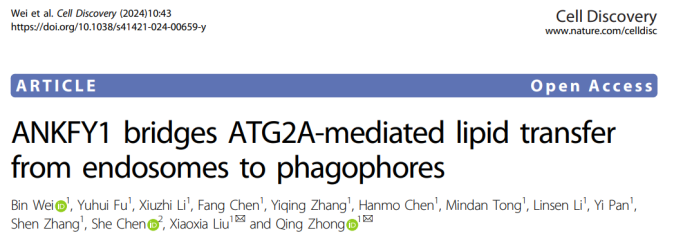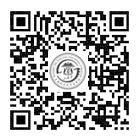On April 16, 2024, the research groups of Qing Zhong and Xiaoxia Liu from the Department of Pathophysiology, Shanghai Jiao Tong University School of Medicine published a research paper titled ANKFY1 bridges ATG2A-mediated lipid transfer from endosomes to phagophores online in Cell Discovery. They found that ANKFY1 can anchor ATG2A to endosomes, where it assists ATG2A in transporting lipids from endosomes to autophagosomes, thus promoting membrane extension of autophagosomes. This illustrates that ATG2A, as a key protein in the lipidtransfer process, mediates lipid transportation between endosomes and autophagosomes. The molecular mechanism of lipid transferbetween endosomes and phagosomes provides strong evidence for endosomes as the source of autophagosome membranes.
Macroautophagy (hereafter autophagy) is an important degradative pathway characterized by formation of double-membraned, cellular material-containing vesicles termed autophagosomes. During autophagosome biogenesis, a flattened membrane structure named phagophore is first formed, which then expands and bends to engulf a portion of cytoplasm, before enclosure to give rise to an autophagosome. The autophagosome would eventually fuse with lysosome, where its cargoes and inner membranes are degraded.
It is estimated that autophagy probably needs to mobilize millions of lipid molecules per cell for phagophore membrane extension while engulfing substrates upon autophagy stimulation. So far, three distinct mechanisms for delivery of lipids for phagophore expansion have been proposed: vesicle-mediated delivery, membrane extrusion from pre-existing organelles, and protein-mediated lipid transport. For protein-mediated lipid transport, lipids can be transferred directly by lipid transfer protein at one or more putative contact sites in close proximity between phagophores and other organelles. As one of the most widely studied proteins in autophagy lipids transfer, ATG2 is widely accepted to facilitate lipid transfer between ER and growing phagophores during the early stages of autophagosome formation, where the membrane contact with phagophore is stabilized by interaction with PI3P effector protein WIPI4 on the phagophore, and the membrane anchoring to ER is accomplished by interactions with ER-resident scramblases. Many different organelles have been implicated as potential membrane sources supporting autophagosome growth. However, so far it is not clear whether ATG2 can transfer lipids from other organelles to phagophores.

In this study, the research group identified ANKFY1(Ankyrin repeat and FYVE domain-containing protein 1) as the ATG2A-interacting protein throughtandem affinity purification. They found that a part of ANKFY1 co-localizes with ATG2A between endosomes and auotphagosomes in cells with autophagy induction. It is speculated that ANKFY1 is involved in the lipid transfer process mediated by ATG2 because with the depletion of ANKFY1, the extension of the intracellular autophagosomes membrane structure is blocked, and the autophagy flux is also blocked at a level similar to the depletion phenotype of ATG2A/B. To further validate this conclusion, the research group constructed a Halo-LC3 stable cell line. This assay was able to specifically detect phagophores, nascent autophagosomes, and mature autophagic structures by sequentially labeling cytosol-accessible and autophagosome-sequestered HT-LC3 by using fluorescently tagged membrane-impermeable (MIL) and membrane-permeable (MPL) HaloTag ligands, respectively. Taken together, depletion of ANKFY1 reduces phagophore growth and closure.
To further explore the function of ANKFY1 in ATG2-mediated lipidtransfer, the researchgroup tried to biochemically reconstitute the biological process of lipidtransfer and established a LipidTransfer Assay based on FRET (fluorescence resonance energy transfer) in vitro. Using this system and combining protein-liposome co-floatation experiments and dynamic light scatteringexperiments, the researchers found that ANKFY1 can bind to PI3P enriched liposomes through the FYVE domain, helping ATG2A to be anchored on the membrane surface, and promoting ATG2 to transfer lipids between liposomes containing PI3P.
Finally, the research group found that intracellular ANKFY1 depletion resulted in a decrease in PI3P content on autophagosomes, a phenotype consistent with ATG2 depletion or UVRAG (which mediates endosomal PI3P production) depletion. These data suggest that ATG2 and ANKFY1 may transfer PI3P lipids from endosomes to the autophagosome membrane structures during autophagy activation.
Master graduate student Bin Wei, Dr. Yuhui Fu, and Dr. Xiuzhi Li from Qing Zhong’slab are the co-first authors of this article, and Professor Qing Zhong and Associate Researcher Xiaoxia Liu are the co-corresponding authors of this article.

